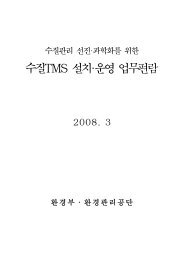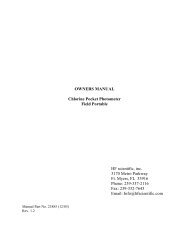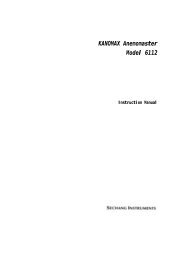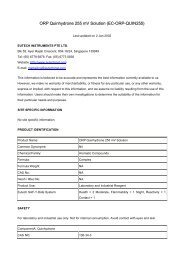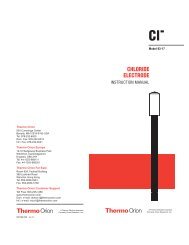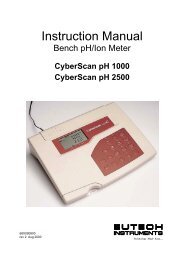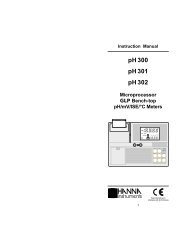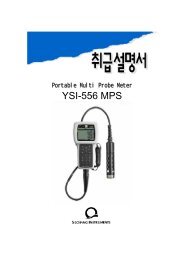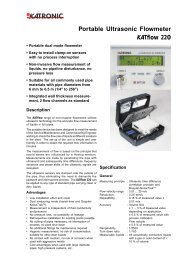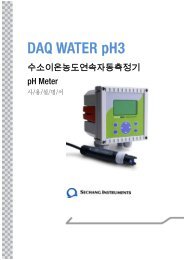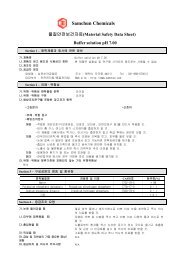INSTRUCTION MANUAL CyberScan pH/Ion 510 - Welcome to ...
INSTRUCTION MANUAL CyberScan pH/Ion 510 - Welcome to ...
INSTRUCTION MANUAL CyberScan pH/Ion 510 - Welcome to ...
Create successful ePaper yourself
Turn your PDF publications into a flip-book with our unique Google optimized e-Paper software.
<strong>CyberScan</strong> <strong>pH</strong> <strong>510</strong>/<strong>Ion</strong> <strong>510</strong><br />
b) Oil / Grease Films<br />
Wash the <strong>pH</strong> electrode bulb in mild detergent and water. Rinse electrode tip with de-ionized water.<br />
c) Clogged Reference Junction<br />
KCl<br />
19<br />
60 - 80 o C<br />
Heat for 10 minutes<br />
Heat a dilute KCl solution <strong>to</strong> 60-80 o C. Place the sensing portion of the <strong>pH</strong> electrode in<strong>to</strong> heated KCl solution<br />
for approximately 10 minutes (as shown above). Care must be taken when performing this procedure. Allow<br />
electrode <strong>to</strong> cool while immersing in some unheated KCl solution.<br />
d) Protein Deposits<br />
Use Eutech’s Protein Cleaning Solution EC-DPC-BT <strong>to</strong> remove any protein that is deposited on<strong>to</strong> <strong>pH</strong> electrode.<br />
Allow the electrode <strong>to</strong> stand in this solution for five <strong>to</strong> ten minutes.<br />
6.4 <strong>pH</strong> Electrode Rejuvenation<br />
CAUTION: Proper protective eyewear and precautionary measures must be used when performing the<br />
rejuvenation procedure as it involves the use of concentrated acid and alkaline.<br />
Generally, if procedure of s<strong>to</strong>rage and maintenance had been closely followed, the <strong>pH</strong> electrode can be used<br />
immediately. However, should the electrode response become sluggish, it may be possible that the glass bulb<br />
has dehydrated. Immersing the electrode in an ideal s<strong>to</strong>rage solution (e.g. buffer <strong>pH</strong> 4 solution) for 1- 2 hours<br />
can dehydrate the glass bulb. If this fails, the electrode may require re-activation. At no time should you <strong>to</strong>uch<br />
or rub the glass bulb as this causes the build-up of electrostatic charge. If the above procedure does not reactivate<br />
electrode <strong>to</strong> acceptable status, try rejuvenating electrode by following the procedure outlined below.<br />
6.4.1 Rejuvenation Procedure<br />
1. Dip and stir the electrode in freon or alcohol for 5 minutes.<br />
2. Leave the electrode in tap water for 15 minutes.<br />
3. Dip and stir the electrode in concentrated acid (e.g. HCl, H2SO4) for 5 minutes.<br />
4. Repeat Step 2.<br />
5. Dip and stir in strong base (NaOH) for 5 min. Leave for 15 minutes in tap water.<br />
6. Test with standard calibration buffer solutions.<br />
Finally, test with standard calibration buffer solutions <strong>to</strong> see if the electrode yields acceptable results. You may<br />
repeat steps ‘c’ <strong>to</strong> ‘f’ again for better response (maximum 3 times). If the response does not improve, then the<br />
electrode has completed its useful life. Replace with a new electrode.



